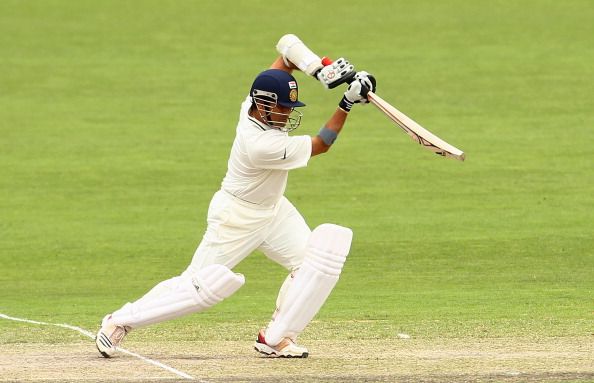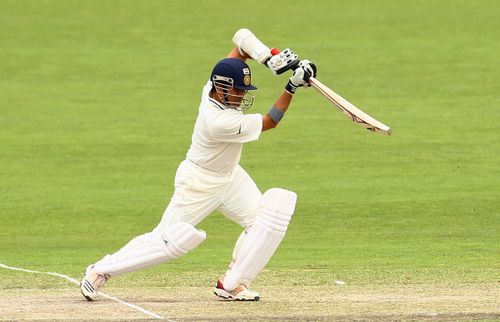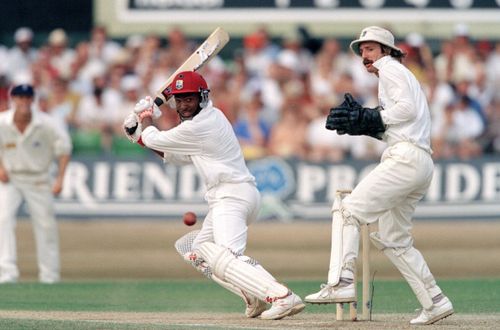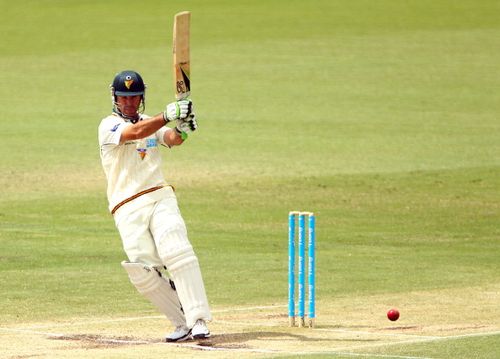
Cricketers and their Trademark Shots
Just like how a magic wand works for an illusionist, cricket’s batting stalwarts manage doing so many tricks with their cricket willows. Though so many innovative shots have come about in cricket with the advent of the shortest version called T20, the ones written in text books always look pleasing when demonstrated. You wouldn’t get tired of seeing those shots repeatedly on TV, and when the specialists play them, the law of diminishing marginal utility usually tends to take the backseat. So much so, one can even identify a player with a particular type of shot, because of the way he executes it with artistic sleight. Let us now have a look at such trademark shots, mastered by some of the best batsmen ever to have walked the Earth.
1.Sachin Tendulkar’s straight drive:

“Everything is right about that shot” – This is how Sunil Gavaskar, seated in the commentary box, has always described the straight drive of Sachin Tendulkar. Well, he is a connoisseur of the shot as well, and so it should not come as a surprise to us that he has an unmatched liking for that shot. No cricketer, past or present, has played straight drives better than the Mumbai batting maestro. The way he keeps his head still and his footwork are the key factors which help him in carrying out this shot crisply. When he completes playing it, everyone watching it on television can view the maker name of his bat, and that has been one of the notable features of the little master’s wizardry. Normally, he keeps the balls all along the ground, but at times, he has also hit them dead straight over the bowler’s head for maximums. That lofted straight drive by Sachin off the bowling of Michael Kasprowicz during the Sharjah Cup final in 1998 against Australia is one of its finest examples.
2. Brian Lara’s Late Cut:

The “Late Cut” definitely cannot be described as one of the standout shots of Brian Lara, as he was adept in playing better ones than that. But he has made it look much better by the manner in which he used to time it. Normally, batsmen feel comfortable playing it against the spinners, as they get more time to place the ball. But the beauty about the “Prince of Trinidad” was that he played this shot against faster bowlers too. For a man like B.C. Lara, who used to have a high back lift, it should have been easily one of the most difficult shots to play. However, on the contrary, he used his bat speed in crafty fashion, playing it so delicately while steering the ball towards the third man boundary.
3. Ricky Ponting’s Pull Shot:

This man might have just retired, but if we should be having one reason for remembering him for ages, then it has to be for his “Pull Shot.” From the time he made his international debut, he had been playing it. Having been brought up in the faster and bouncy pitches of Australia this was one shot which came pretty easily to him. He just did not love taking evasive action against the balls which had bounced above his hips or shoulders. No matter at what pace the balls were delivered, he had forever successfully targeted the mid wicket area whenever the balls breached his hips. The key to executing this shot is the clear-cut hand and eye co ordination and the Tasmanian right hander seemed to have owned it well under his grasp.
4. Rahul Dravid’s Pull shot:
Unlike Ponting, Dravid had not played pull shots consistently, but then throughout his career he struck them very well whenever he attempted at playing them. Not many Indian batsmen were known to be great exponents of horizontal bat shots, but the Karnataka batsman was one of those exceptions. He even used this shot effectively against a bowler of Shoaib Akhtar’s pace.
Difference between Ponting and Dravid’s pull shot:
Per se, Dravid’s pull shot was nowhere close to the class of Ponting’s. But then, the Indian batsman used to execute it very safely. The Australian used to hit it over the midwicket fence and so the chances of him getting holed out at the boundary line were never ruled out. Whereas Dravid had always adopted a risk-free approach of playing it by rolling the wrists at the point of contact, which had helped him keep the ball all along the ground. So he had hardly got out pulling the ball unlike Ponting.
Aravinda De Silva’s drives on the up:

You have to be a very good backfoot player to drive on the up, and this Sri Lankan batsman was more than comfortable with it. He never needed more than a little room to caress the ball off his back foot. Since he had always been well balanced off his toes while batting, he went about striking it with phenomenal grace and ease. Be it cover drives or square drives, he was the best ever to play them on the up. The semifinals of the 1996 World Cup against India at Eden Gardens, Kolkata saw him drive brilliantly right from the word go. Nathan Astle of New Zealand also used to play them well, and among the present cricketers Jacques Kallis looks to have a penchant for hitting them.
Daryll Cullinan’s cover drive:
If you want to see a touch of elegance and grace, then you need to watch videos of this veteran South African playing cover drives. The way he used to play the cover drives, I bet, would mesmerize you. He was one of the most stylish right handers in the game, who used to time the balls so well on the off side. The only problem he had throughout his career was his failure against the legendary leg spin of Shane Warne. Against every other bowler, including spinners, he used to hit some rollicking cover drives all along the ground.
Gundappa Vishwanath’s square cut:
Though we have seen the Sehwags and Jayasuriyas playing vicious square cuts, no one till date has done it as effectively as G.R.Vishwanath. This former Indian captain was also known as the “square cut specialist” for this very reason. Even the menacing fast bowling quartet of the West Indies in the 70s were in the firing lane whenever they bowled to this veteran Indian. He did so well against some quality pace bowlers on faster pitches because of his in-born ability to cut the ball. He used to find the boundaries without playing them in the air, unlike some of the modern day batsmen.
Leg side flicks of Mark Waugh, Mohammed Azharuddin and VVS Laxman:
Playing a ball on the leg side requires a batsman to have a good wrist work. Mark Waugh of Australia and the two Indians – Mohammed Azharuddin and V.V.S.Laxman were the three batsmen who could use their wrists to the best effect possible. Anything which was bowled at leg and middle to them had reached the boundaries on the onside. In fact, even those balls which were directed at their off side used to be skillfully flicked on the leg side by the trio. The sad part is that the world is yet to see their replacements.